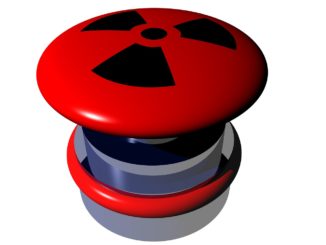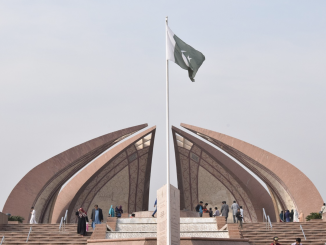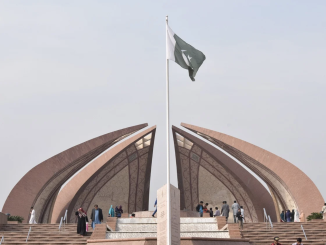 The potential for tension in relations amongst states has always existed. From the conflict between the Greek-city states and the Thirty Years’ War to both World Wars, the nature of warfare has evolved. The advent of nuclear weapons and their use against the rivals has only resulted in massive destruction, with after-effects that can be observed long after. The repercussions of using such weapons made the international community realize the need for being responsible. Many international laws for the prohibition of such weapons were made, including the Non-Proliferation Treaty (NPT), the Treaty on the Prohibition of Nuclear Weapons, and the Comprehensive Nuclear Test Ban Treaty (CTBT) etc. These serve particular purposes and are considered the main contracts prohibiting states that are party to them from passing on lethal nuclear technology.
The potential for tension in relations amongst states has always existed. From the conflict between the Greek-city states and the Thirty Years’ War to both World Wars, the nature of warfare has evolved. The advent of nuclear weapons and their use against the rivals has only resulted in massive destruction, with after-effects that can be observed long after. The repercussions of using such weapons made the international community realize the need for being responsible. Many international laws for the prohibition of such weapons were made, including the Non-Proliferation Treaty (NPT), the Treaty on the Prohibition of Nuclear Weapons, and the Comprehensive Nuclear Test Ban Treaty (CTBT) etc. These serve particular purposes and are considered the main contracts prohibiting states that are party to them from passing on lethal nuclear technology.
Many individuals and organizations have been advocating for the need to curb the dangers emerging from fatal use of nuclear energy. Indeed, it was proposed in a resolution of the United Nations General Assembly passed in January 1946 that atomic weapons be eliminated from state arsenals. The United States, which first produced and used these weapons, was the first to propose an international authority to monitor and regulate all affairs related to nuclear energy. This proposal came to be known as the Baruch Plan, but it was unsuccessful due to non-compliance. In 1949, the Soviet Union also attained nuclear power weapons, followed by the UK in 1952, France in 1960 and China in 1964.
These countries were major powers at that time and it was obvious that they would enter the nuclear paradigm eventually. However, upon realization that the nuclearization of other countries would pose a grave threat to world security, these powers decided to develop a treaty which would clamp down on the proliferation of weapons. For this purpose, in 1968, a treaty was signed for the Non-Proliferation of Nuclear Weapons which placed various restrictions at the national and international levels on the signatory countries. The International Atomic Energy Agency (IAEA) was established with the responsibility for regulating the usage of nuclear energy for peaceful purposes, and to report any violations in the form of using nuclear energy for making bombs. All member states are required to undergo safety measures taken by the IAEA in this regard. The treaty also allows member states to carry out civilian use of nuclear energy and nuclear states signatory to it, i.e. the big powers, are to provide and help other states in civilian use of nuclear technology. This treaty so far has been successful as it attracted almost 171 countries as its adherents. However, states like Pakistan, India, North Korea and Israel are not party to this treaty, mainly due to the threat of war and the evolving nature of conflict.
Another regime which was introduced for the non-proliferation of nuclear arms is known as the Comprehensive Nuclear Test Ban Treaty (CTBT) that was adopted by the United Nations General Assembly in September 1996. This treaty thoroughly bans testing of any kind of nuclear expedient. Under the provision of this treaty, a CTBT organization has been established in Vienna to ensure the implementation of treaty instructions and to detect any violation done by member states. Till now, 183 countries have signed this treaty and nearly 164 of them have ratified it. There are 44 states which are members of the Conference of Disarmament (CD) with regards to nuclear reactors or power. Among these 44 states, 5 states have not ratified the CTBT, but have signed; these are the US, China, (members of NPT), Iran, Egypt and Israel. Pakistan, India and South Korea remain states who have not even signed this treaty.
At the moment, strained relations between Pakistan and India are posing a serious threat. Both countries are nuclear capable and war between the two is under international debate, especially after events such as the Pulwama attack, the Balakot airstrike and the Indian Government’s revocation of Article 370 and 35A. These states have several longstanding issues and they have fought several non-nuclear wars against each other throughout the course of their independence. Nowhere is there a greater threat of an outright nuclear war than between these countries. Both countries have undergone a nuclear race with growing nationalism, making them a flashpoint which could lead to a nuclear disaster. India being the emerging power in South Asia has rejected the CTBT, saying it is not an option “not now, nor later”. They have insisted that they would want to exercise their nuclear testing option.
On the other hand, Pakistan, also a nuclear armed country, reviews its nuclear policy over concerns and threats from India and considers it an essential element to ensure nuclear deterrence in the region. The enormous production of Intercontinental Ballistic Missiles (ICBM’s) and sea based nuclear missiles by India poses an additional threat to Pakistan. Hence, it has shown its reluctance in becoming a part of any such treaty which would ban the acquisition of nuclear technology and the testing of nuclear capability. However, because Pakistan’s stance is based on the Indian position; it has offered India multiple times to enact a “mutual nuclear test ban arrangement”. That would mean a bilateral nuclear arrangement between the two countries which would legally bind both of them against any nuclear testing. India has rejected Pakistan’s offer and insisted on ratification by China and the US first. Pakistan has shown interest in adopting the CTBT in the past as it supported the objectives of the CTBT in the UNGA and by declaring that they would not be the first to test any further nuclear device in the region. Moreover, in order to abstain India from acquiring sea based nuclear armed vehicles, Pakistan has asked to declare the Indian Ocean a nuclear free region. But India rejected this offer and acquired nuclear capable missiles and submarines, compelling Pakistan to follow the course it did.
The two major nuclear powers in the South Asian region possess the capability of delivering nuclear armed missiles from land, sea and air, thus completing the nuclear triad. With modern missiles and heightened tensions over Kashmir there is every chance of a nuclear war between these two countries. Both countries might change their nuclear strategies as the threat intensifies “from peacetime to crisis”. Indian Defense Minister, Rajnath Singh has recently commented that India might change its “no first use policy” if recent tensions with Pakistan on Kashmir do not ease. On the other hand, Pakistan, which had developed nuclear bombs just to counter the conventional threat it faced, would not hesitate to respond in a befitting manner.
In order to reduce the chances of a nuclear war, these countries need to reconsider their stance on non-proliferation treaties. They must also opt for dialogue and utilize their good offices and diplomatic channels to avoid nuclear clashes. Major powers need to play a responsible role by using settlement techniques and work as arbitrators before further escalation between the two states.
![]()




Very useful Article